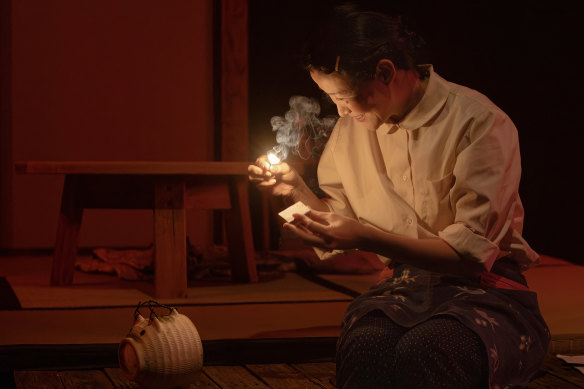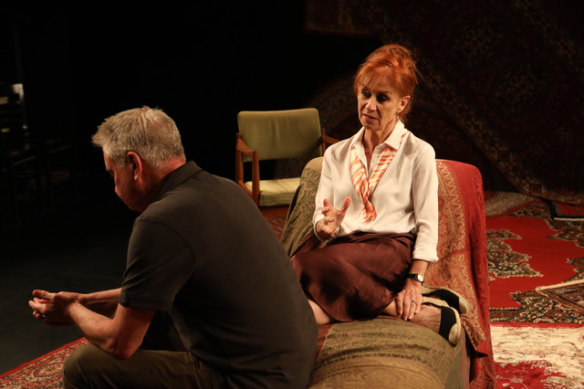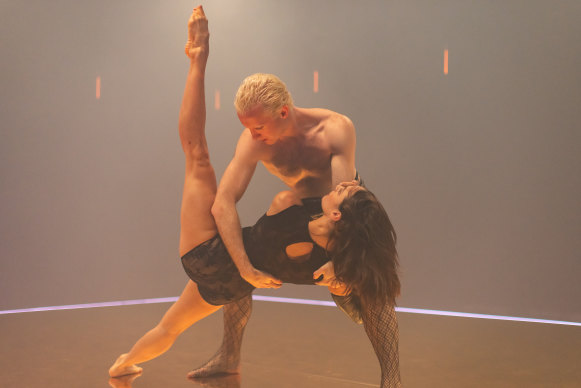Emotional fallout: Father and daughter reconcile in shadow of mushroom cloud

Save articles for later
Add articles to your saved list and come back to them any time.
THEATRE
THE FACE OF JIZO
Old Fitz Theatre, November 1
Until November 11
Reviewed by JOHN SHAND
★★★★
The play transforms itself in a moment, just as the lives of everyone in Hiroshima were either ended or transformed at 8.15am on August 6, 1945. Until this moment, Hisashi Inoue’s gentle drama has a father and daughter discussing all that’s little or large in her life in the city three years after the detonation of the first atomic bomb. This still looms over them, making storms – with their white flashes and thunderclaps – a terror.
She is Mitsue (Mayu Iwasaki), a 23-year-old librarian. Her father, Takezo (Shingo Usami), we gradually come to realise, is not really there. He might be a ghost, or he might live in her mind and heart – both riddled with guilt because she survived the blast and he didn’t.
Mayu Iwasaki plays 23-year-old Mitsue who is riddled with guilt because she survived the blast.Credit: Phil Erbacher
Takezo is as practical, wise, humorous and caring as he was when alive; keen for Mitsue to find the happiness that will render his presence redundant. The fastest path to that felicity – apart from learning to forgive herself for being one of those to live – would be if she accepted the advances of a young man who frequents the library, singling Mitsue out with gifts, such as a bean jam bun. Her suitor seeks information about the effects of the bomb, but the occupying army prohibits such material.
The transformation comes when Takezo tells us of the heat the bomb generated, which was twice as hot as the surface of the sun, the fireball instantly erasing or melting everything it hit – and that was before the shockwave and the radiation.
Inoue, who died in 2010, renders the enormity of the catastrophe in tiny details and personalised impacts. His play, caringly translated by Roger Pulvers, is about the way we negate our humanity in the name of war, and it is also about the nature of storytelling.
Mitsue and Takezo are kind, likable people, played with great warmth by Iwasaki and Usami, with the latter also co-directing the production with David Lynch. You sense the actors, who are still occasionally insecure in their lines, will grow further into the roles, and audiences will feel for and be charmed by their characters all the more.
Japanese theatre has been ignored here, so this was a brilliant choice of play, and further evidence Red Line Productions is Sydney’s most widely questing company.
THEATRE
THE LIVES OF EVE
KXT on Broadway, November 1
Until November 11
Reviewed by KATE PRENDERGAST
★★★
“You do go on, don’t you!”
This line, delivered with prim fruitiness by stage doyenne Annie Byron – here as a dazzlingly gowned ghost-mother – draws the first gust of laughter from the audience. We have just begun the second act of Stephen Sewell’s new play, the Australian’s first on-stage production since 2019.
Noel Hodda and Helen O’Connor in The Lives of Eve.Credit: Danielle Lyonne
The troubled characters in the story do indeed go on, which is perhaps to be expected given the two settings are a psychoanalyst’s office and a home in which a marriage of many years is falling apart. A lot of talking was bound to happen. Gradually we come to understand the play as a study of language and its potential to transform and to obliterate.
Still, particularly in the first half (in which tragically Byron has only one scene), this relentless talking is exhausting. And while the second half is partly redeeming, it feels at times as though Sewell is working through his own ideas of “what it means for women to exist in this world”, with much focus on how female orgasm relates to this question, and whether the (presented as binary) genders can get along. Kim Hardwick’s direction keeps much of the play’s intentions veiled.
Hannah Yardley’s set features floor-to-ceiling Persian rugs, while Sewell’s characters are also complex creations running up the walls. Helen O’Connor is our titular psychoanalyst, played with a spiky strangeness that goes from unnerving stoicism to yelling at patient Sylvia that she “can’t orgasm because she doesn’t want to give men the satisfaction.”
Sylvia happens to be the other side of the same coin, played with promise by newcomer Louisa Panucci. Noel Hodda is Sylvia’s husband, endearing yet doomed by his conventional ideas of love. Free of worldly concerns, Sylvia’s dead mother is the most sanguine.
At two hours plus, The Lives of Eve wants too urgently to get to the thick of its ideas. You’re hardly introduced to the characters before they begin dissecting themselves and tearing each other apart. It gives you a lot to parse – much feminist and penis-centric psychoanalytic theory – and the result is a wary puzzlement as to where exactly it lands.
DANCE
Up Close: Somos
Sydney Dance Company, Neilson Studio
November 1
Until November 18
Reviewed by CHANTAL NGUYEN
★★★★
Sydney Dance Company bills its latest work, Up Close: Somos, as being all about intimacy.
That theme is reflected in the venue – it’s the first SDC work to be performed in the company’s home studio in Walsh Bay, where audiences are seated in the round less than three metres from the dancers.
The piece is also about artistic director Rafael Bonachela’s Spanish roots. For the score, Bonachela collected songs by his favourite Hispanic chanteuses, representing the “sounds of [his] childhood”. Parts of Somos were choreographed during a residency in Madrid, immersing the dancers in Spanish life and allowing sound designer Nick Wales to roam the streets, recording the hum of Spanish crowds for use in the score.
The choreography has Rafael Bonachela’s trademark athletic complexity.Credit: Pedro Greig
To top it all off, the usual SDC studio cafe has been transformed into a cosy tapas bar, complete with guitarist and lemon trees.
Somos is visually striking, beginning with the dancers behind a gauzy shredded curtain (Kelsey Lee’s
set design), which rises slowly to reveal them dancing sensuous duets and ensembles on a small
mirror stage.
It’s all up close and personal, every sinew and muscle in view under Damien Cooper’s masterfully intimate, hazy lighting. Combined with the crooning music and Lee’s cabaret noir costuming, you can practically smell the cigarette smoke and nightclub booze.
The intimate venue also showcases a different side to Bonachela’s choreography. With no space for
his usual high-speed leaps and dizzying turns, Bonachela opts for an earthier, more grounded sensuousness. The choreography still has his trademark athletic complexity though, with the dancers interlocking limbs like living Tetris puzzles, sliding themselves into remarkable lifts and dives.
For all its talk of true intimacy, Somos dips into depersonalising sexual objectification. Watching the
dancers through the gauze curtain makes you feel like a voyeur peering into a dressing room. Most of the dance scenes have the same moody eroticism that, while initially compelling, feels one dimensional after a few numbers.
The sexuality is emphasised by Lee’s costuming: all BDSM rips, lace, and leather. A gripping heartfelt solo by Jesse Scales and emotionally complex duets by Riley Fitzgerald and Dean Elliott bring relief, reminding us that genuine intimacy transcends a perfect sexualised body and reflects the whole person’s thoughts, feelings, and lived experience.
But despite these aspects, Somos remains an impressive work and – clocking in at under an hour – a good introduction to dance.
MUSIC
Alexander Gavrylyuk performs Tchaikovsky
Sydney Symphony Orchestra
Opera House Concert Hall, November 1
Reviewed by PETER MCCALLUM
★★★★
Alexander Gavrylyuk played fast and loud in Tchaikovsky’s Piano Concerto No. 1 in B flat minor, hammering the majestic opening chords and dominating the first movement without a hint of reticence. In the quieter orchestral episode that introduced the slow movement, flautist Emma Sholl introduced a note of simplicity against delicately plucked strings before Gavrylyuk took up the same theme, moulding it with expressive angst boldly worn on his sleeve.
In the last movement, he rattled out the main theme, with its characteristic offbeat accent, double notes and slick ornamental twirl with brittle crispness. Just before the climactic return of the more romantic second theme, Gavrylyuk produced a thunderous roulade of octaves with jackhammer force. It was a caricature performance of forceful virtuosity, made for the cameras dotted around the hall, and the audience leapt to their feet and cheered.
By contrast, one solitary audience member ostentatiously booed Métaboles by Henri Dutilleux which started the concert, an undeservedly churlish response, in my view, to a performance conductor Donald Runnicles and the Sydney Symphony had crafted with exquisite care and refined subtlety.
Métaboles is a set of five carefully etched sections, each taking a theme, mutating it and passing on the changed version to the next. This process has its own fascination somewhat like watching the variations that occur in nature between well-formed and less well-formed samples of the same plant. Yet what gives the work its expressive shape and coherence is the distinctive orchestral colour Dutilleux finds for each section.
There is sharply cornered, ritualistic character to the wind playing in the first part, and warm sound of consolation from the strings in the second. The third has disorienting jabs from brass, leading to ethereal hushed percussion in the fourth, punctuated by eerie chords on double bass harmonics evoking other-worldly illumination. The final section completes the cycle and restores the opening theme.
Runnicles and the SSO delivered equally refined nuance in the first two of Debussy’s Images. Oboist Shefali Pryor set the mood of light energy in Gigues. The three movements of Ibéria make Spain into a magical world where energy and fleeting images flash suggestively and vanish leaving a lingering afterglow on the retina and the imagination. The last movement, evoking the bright energy of a festival day morning, bristled with scintillation and delight.
The Booklist is a weekly newsletter for book lovers from books editor Jason Steger. Get it delivered every Friday.
Most Viewed in Culture
From our partners
Source: Read Full Article


